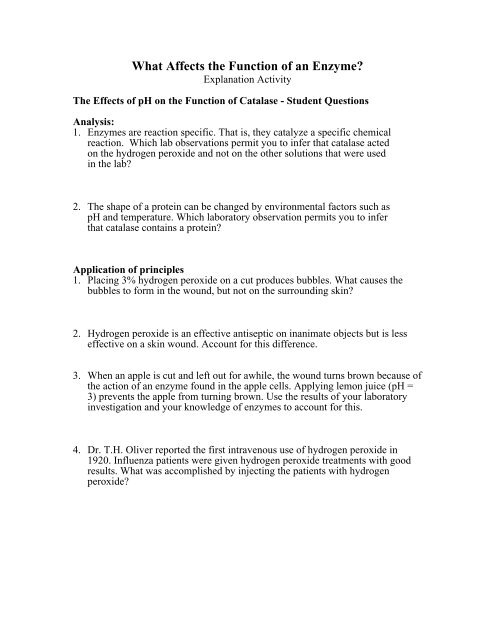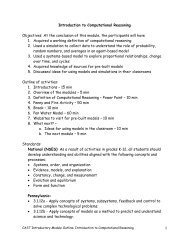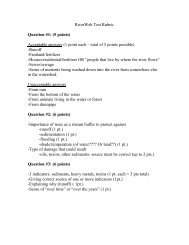What Affects the Function of an Enzyme?
What Affects the Function of an Enzyme?
What Affects the Function of an Enzyme?
Create successful ePaper yourself
Turn your PDF publications into a flip-book with our unique Google optimized e-Paper software.
The Effects <strong>of</strong> pH on <strong>the</strong> <strong>Function</strong> <strong>of</strong> Catalase - Answer KeyObservations:Table 1: Results <strong>of</strong> a study <strong>of</strong> <strong>the</strong> effects <strong>of</strong> pH on enzyme behavior.Test performed pHTest result(+/-)Additional observationsWater 7 +Bubbles form around <strong>the</strong> potato.The slices float to <strong>the</strong> surface.Vinegar 2- 3 - No reaction occurs.0.1 M NaOH 13 - No reaction occurs.Detergent 10 – 11 +The reaction that occurs is notas vigorous as it is with water.Analysis:1. <strong>Enzyme</strong>s are reaction specific. That is, <strong>the</strong>y catalyze a specific chemicalreaction. Which lab observations permit you to infer that catalase acted on <strong>the</strong>hydrogen peroxide <strong>an</strong>d not on <strong>the</strong> o<strong>the</strong>r solutions that were used in <strong>the</strong> lab?Bubbles did not form when <strong>the</strong> solutions were added. Bubbles formedonly after <strong>the</strong> hydrogen peroxide was added.2. The shape <strong>of</strong> a protein <strong>an</strong>d its ability to function c<strong>an</strong> be ch<strong>an</strong>ged byenvironmental factors such as pH <strong>an</strong>d temperature. Which laboratoryobservation permits you to infer that catalase contains a protein?The tests at <strong>the</strong> extreme pH values (acetic acid <strong>an</strong>d sodium hydroxide)produced negative results while <strong>the</strong> o<strong>the</strong>r tests were positive.Application <strong>of</strong> principles1. Placing 3% hydrogen peroxide on a cut produces bubbles. <strong>What</strong> causes <strong>the</strong>bubbles to form in <strong>the</strong> wound, but not on <strong>the</strong> surrounding skin?The damaged cells around <strong>the</strong> wound release catalase (or some similarenzyme). The unbroken skin around <strong>the</strong> wound does not release catalase.2. Hydrogen peroxide is <strong>an</strong> effective <strong>an</strong>tiseptic on surfaces but is less effectiveon a skin wound. Account for this difference.Since catalase is present at <strong>the</strong> site <strong>of</strong> a skin wound, hydrogen peroxide isbeing decomposed rapidly. Surfaces do not have enzymes <strong>an</strong>d so <strong>the</strong>hydrogen peroxide lasts longer <strong>an</strong>d c<strong>an</strong> more effectively kill <strong>an</strong>y bacteriain <strong>the</strong> area.3. When <strong>an</strong> apple is cut <strong>an</strong>d left out for awhile, <strong>the</strong> wound turns brown because<strong>of</strong> <strong>the</strong> action <strong>of</strong> <strong>an</strong> enzyme found in <strong>the</strong> apple cells. Applying lemon juice (pH= 3) prevents <strong>the</strong> apple from turning brown. Use <strong>the</strong> results <strong>of</strong> your laboratoryinvestigation <strong>an</strong>d your knowledge <strong>of</strong> enzymes to account for this.<strong>Enzyme</strong> action is affected by <strong>the</strong> pH <strong>of</strong> <strong>the</strong> environment. The result <strong>of</strong> <strong>the</strong>acetic acid test shows that a low pH prevents <strong>an</strong> enzyme fromfunctioning.
4. Dr. T.H. Oliver reported <strong>the</strong> first intravenous use <strong>of</strong> hydrogen peroxide in1920. Influenza patients were given hydrogen peroxide treatments with goodresults. <strong>What</strong> was accomplished by injecting <strong>the</strong> patients with hydrogenperoxide?Hydrogen peroxide, in <strong>the</strong> presence <strong>of</strong> catalase, was rapidly converted towater <strong>an</strong>d oxygen. The oxygen level <strong>of</strong> <strong>the</strong> blood increased. Note: <strong>the</strong><strong>an</strong>swers to problems 1 <strong>an</strong>d 2 provide evidence for inferring that catalaseis present in <strong>the</strong> blood.Conclusions:1. State <strong>the</strong> pH r<strong>an</strong>ge in which catalase c<strong>an</strong> decompose hydrogen peroxide.Catalase decomposes hydrogen peroxide when <strong>the</strong> pH is between 3 <strong>an</strong>d13.2. <strong>What</strong> environmental factors affect <strong>the</strong> rate at which <strong>an</strong> enzyme functions?Temperature, pH, <strong>an</strong>d salinity affect <strong>the</strong> rate at which <strong>an</strong> enzymefunctions. The results <strong>of</strong> this lab demonstrate <strong>the</strong> effects <strong>of</strong> pH on <strong>the</strong>enzyme rate.3. How does <strong>the</strong> protein portion <strong>of</strong> <strong>an</strong> enzyme affect <strong>the</strong> behavior <strong>of</strong> <strong>the</strong> enzyme?Proteins have specific shapes that c<strong>an</strong> be altered by environmental factorssuch as pH <strong>an</strong>d temperature. Altering <strong>the</strong> shape <strong>of</strong> <strong>the</strong> protein also alters<strong>the</strong> shape <strong>of</strong> <strong>the</strong> enzyme, affecting its behavior.








